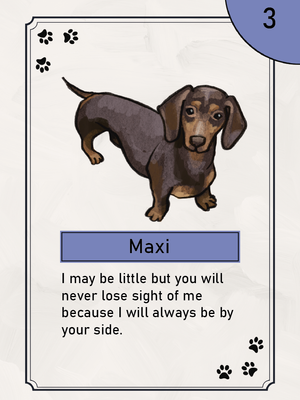Save the Dogs




Fact sheet:
-
Physical card game for 2 to 4 players.
-
Audience: Teenagers and young adults.
-
Team: 1 member + external artist collaborator.
-
Development: 3 months.
My role:
-
Game designer
-
Writer
Artist collaborator - Stephanie Redwood
My goal: Creating an entertaining short protest game around the theme of dog abandonment, and the harsh realities dog shelters with limited resources face everyday.
Research:
According to RSPCA, as of 2022, over 22.000 dogs in the UK were abandoned by their owners. In the US, it is estimated that 20% of cats and dogs are homeless, either living in frequently overrun shelters (with the pending danger of euthanasia) or suffering on the streets.
This game is meant to make players notice the large number of dogs that are abandoned, neglected or born on the streets every year, and how some dogs are prefered over others when it comes to adoption. Puppies (especially purebreeds) have a higher chance of getting adopted, while dogs with certain characteristics have a lower chance. For example: being seniors, disabled, a bully breed, and even having a black fur coat.
Save the Dogs is a card game about rescuing dogs. It was created as a protest to bring light to the amount of animals that are abandoned every year around the world, and how not every dog gets the same chance to get adopted based on their characteristics.

Describe your image

Describe your image

Describe your image
Cards: There are three categories of cards clearly marked by colors in relation to the level of difficulty to get a dog adopted, and point value system.
-
Green - Popular breeds of puppies. Easier and quicker to get adopted. Worth 1 and 2 points.
-
Blue - Mixed or purebreed adult dogs. Slightly more difficult to get them adopted. Worth 3 and 4 points.
-
Red - Dogs that display one or more characteristics that make their adoption harder. Worth 5 and 6 points.
Every dog card comes with a unique name and a funny, cute or emotional background story for that specific dog.

Describe your image

Describe your image

Describe your image

Describe your image
Design process:
As a game designer, my main challenge was figuring out how to get my message across in a way that was easily understood for a young audience, but was also a fun experience for players. In order to best showcase the different ways society views stray dogs and how likely they are of getting adopted, I decided to make up a point system based on the numbers on a D6 die. Players can move any number of dog cards where the sum of the points is lower or equal to the number rolled on D6. Which means, players are more likely to be able to move several dogs with a low point value at a time than a single dog with a high point value.
However, the value of dog cards also determines who wins the game. This design choice was made on purpose so players must choose their strategy. Either risk saving dogs that are worth more points in the end, or choose dogs with lower points which are likely to be moved over the available spaces quicker. I also purposely decided to give higher points to dogs with characteristics that in real life would make their adoption harder, because I wanted to show how these dogs, which are often considered less valuable to society, can actually bring a lot of love, happiness and appreciation to a family.
A design choice I had to make very early on in the development process was how to introduce the dogs to the game. My goal was to ensure a somewhat steady flow of new dogs added to the streets on almost every round to represent how quickly and often dogs are abandoned, but without the risk of running out of dog cards before the game is over. I ultimately decided on the use of a special die with the number 0, 1 and 2. Through playtesting I found that at the end of the game, no matter who the winner is, there will still be a number of dogs on the street that players won't be able to save.
The adoption card is divided in 4 segments representing general steps real shelters make in the process of getting a dog adopted. This is to show how the adoption process can be slow in order to find the best home and family match possible. Every shelter works in a different way, especially in different countries, but I found these steps to be intuitive.
The overall experience is of a casual game with fast rounds that evokes a mix of fun, wholesome, and conflicting feelings. My aim is to make players connect with the dogs, to make them interested in their stories and want to save them. That is why their designs have a certain level of realism, and their stories are unique for each card.






